DevOps and CI/CD: DevOps Best Practices for Agile Development
-
Caploitte
-
15 April 2024
-
05 Min Read
What is DevOps?
How crucial DevOps is?
What is Agile development?
Principles of the Agile Manifesto
Difference Between CI and CD
How does Agile development relate to CI/CD?
How code quality and teamwork are enhanced by continuous integration?
Top Recommended Approaches for Using DevOps
Conclusion
What is DevOps?
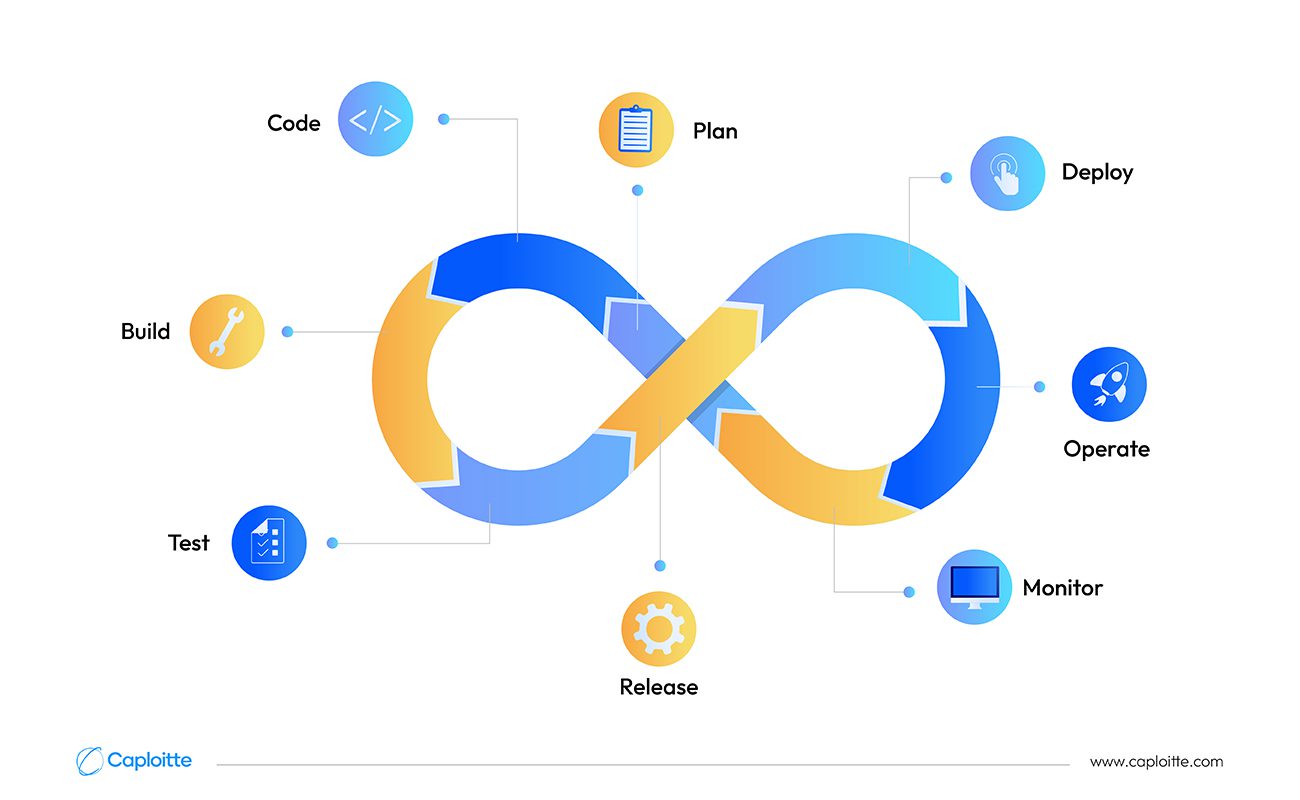
Software engineering and deployment processes are referred to as CI/CD practices. DevOps is best understood as a business initiative to enhance coordination and communication between the development and operations teams in order to accelerate and optimize software deployment. Processes known as Continuous Integration and Continuous Delivery (CI/CD) are available to address a variety of SDLC issues. It’s a novel approach to work with far-reaching effects for teams and the companies they represent. It essentially expedites the cycles of development and release while preserving the caliber of the program. To have a deeper understanding of the differences between CI and CD, it is essential to delve into their details.
How crucial DevOps is?
Even though a DevOps transformation involves changing corporate procedures and structures, the work is well worth it. Ninety-nine percent of participants in our 2020 DevOps Trends poll stated that DevOps improved their organization. In addition to accelerating time to market, DevOps improves quality as well; top teams have a change failure rate that is seven times lower than that of underperforming teams.
What is Agile development?
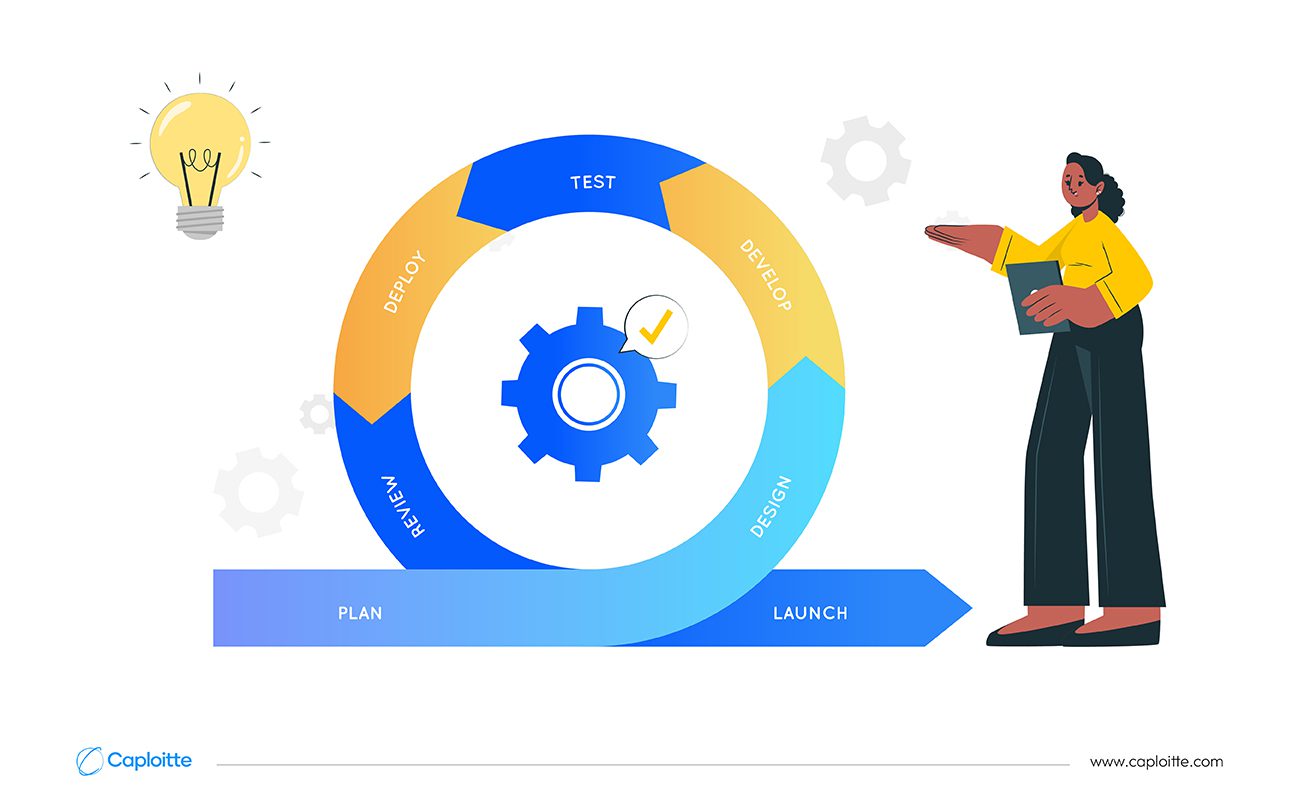
The goal of agile, which some of its manifesto writers now refer to as agility, is to break down process barriers so that important stakeholders—such as customers and developers—can work together more closely to accelerate delivery. Agile development emphasizes how change is constant and accepts that, as software developers, we frequently lack the expertise necessary to properly conceptualize, create, and deploy high-quality products within monolithic life cycles.
Principles of the Agile Manifesto
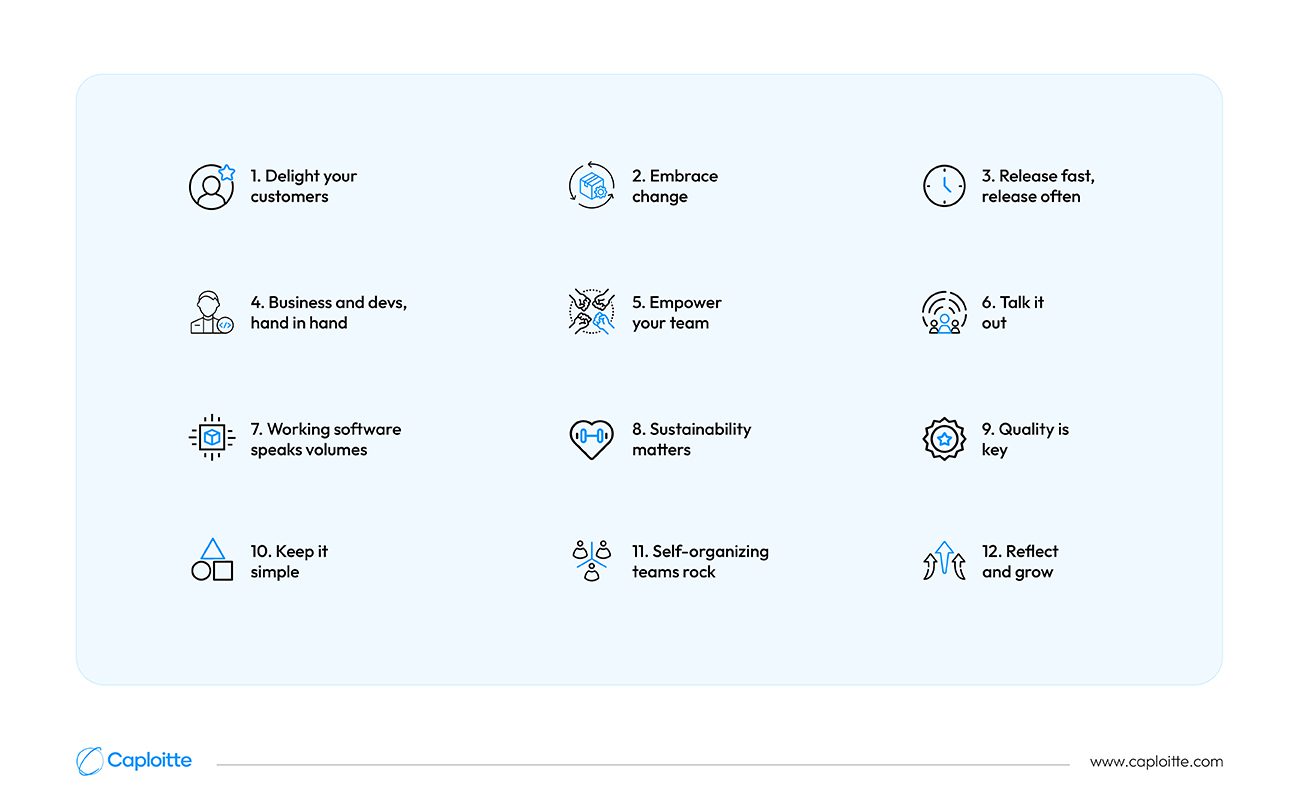
Software development was transformed by agile. Its origins may be traced back to the 2001 publication of the Agile Manifesto, which presented a completely new approach to software project management in contrast to the then-dominant waterfall methodology. Nowadays, most software development companies are built on the widely accepted Agile principles.
Even if agile is becoming commonplace, teams still need to understand its tenets and make sure they are applying them appropriately. Organizations may enhance software quality and expedite application delivery by implementing agile values and the 12 agile principles correctly. More significantly, when applied correctly, agile techniques ought to increase development productivity while enhancing the health and happiness of developers.
Here are the 12 agile principles to keep in mind:
1. Delight your customers:
Deliver valuable software early and often to keep them happy and engaged.
2. Embrace change:
Welcome new ideas, even late in the game, to turn challenges into opportunities.
3. Release fast, release often:
Get working software into users’ hands in weeks or months, with a preference for shorter cycles.
4. Business and devs, hand in hand:
Collaborate daily to ensure everyone’s on the same page and goals are aligned.
5. Empower your team:
Trust and support motivated individuals to do their best work and create magic.
6. Talk it out:
Clear and direct communication, especially face-to-face, is key for a smooth-running team.
7. Working software speaks volumes:
Forget fancy reports, focus on delivering functional software that proves progress.
8. Sustainability matters:
Pace yourselves! Developers, sponsors, and users should be able to work at a healthy rhythm over time.
9. Quality is key:
Write clean, well-designed code that adapts easily to change and future needs.
10. Keep it simple:
Do more with less. Focus on delivering what truly matters and avoid unnecessary complexity.
11. Self-organizing teams rock:
Write clean, well-designed code that adapts easily to change and future needs.
12. Reflect and grow:
Regularly assess your process, identify areas for improvement, and adapt to become even more effective.
Difference Between CI and CD
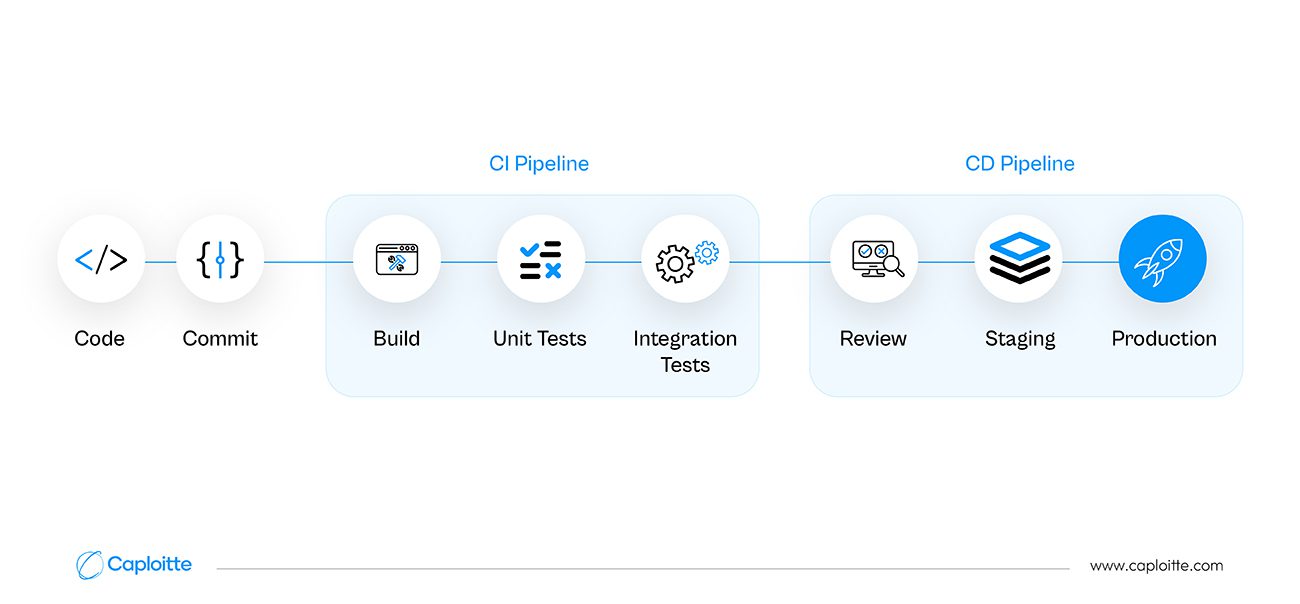
Continuous integration (CI) integration has traditionally been an expensive technical endeavor. Thus, continuous integration (CI) places a strong emphasis on automation tools that support build and test, with the ultimate goal of realizing a software-defined life cycle. Successful continuous integration (CI) reduces build and integration work and enables teams to identify integration faults as soon as possible.
As continuous integration (CI) is to develop and test, continuous delivery (CD) is to packaging and deployment. Software may be built, configured, packaged, and deployed by teams using continuous integration (CD) in a method that allows for software-defined software releases to production at any time, with high automation and low cost.
The goal of continuous integration (CI) is to provide a software-defined lifecycle that minimizes the work needed for build and integration. Early discovery of coding problems is another benefit of continuous integration.
Continuous Delivery, or CD, is the process of making sure that code is always ready for deployment. Every update to the code, including experiments, bug repairs, new features, and configuration adjustments, is always prepared for deployment to a live environment. Making deployments normal activities that can happen on demand at any time is the goal of CD. It makes little difference if an embedded system, a large-scale distributed system, or a sophisticated production environment are involved in the deployment.
Having the appropriate CI/CD technologies in place is critical for each of these processes. A CI/CD pipeline cannot function without the best tools available. Continuous integration (CI) pushes teams to regularly integrate their work. Employees who adhere to this protocol strive toward integration on a daily, if not hourly, basis.
How does Agile development relate to CI/CD?
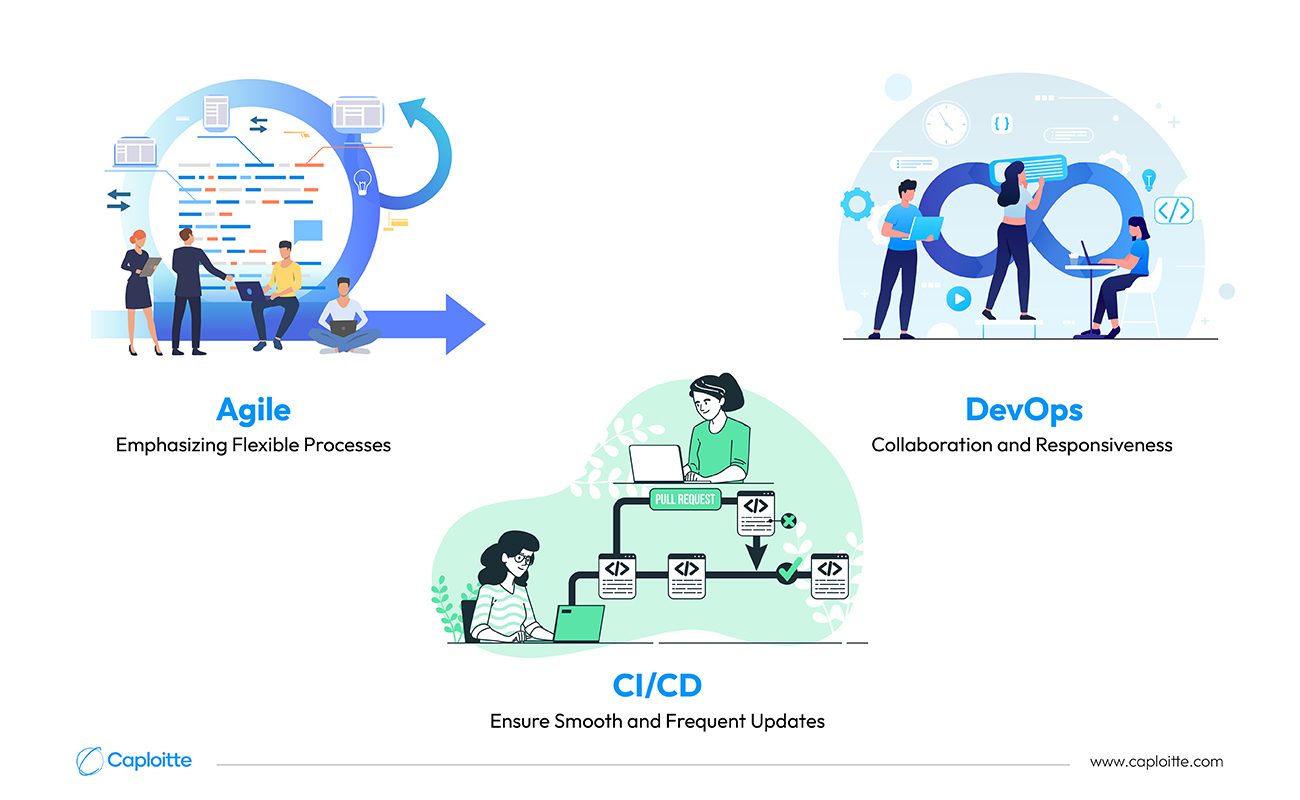
In practical development, how do CI/CD, agile, and DevOps connect to each other? Given that engineering teams are experts in CI, they frequently begin with it. Organizations may create a more meaningful CD approach by understanding what configuration, packaging, and orchestration are required to software-define even more of the life cycle with the aid of a DevOps emphasis. In turn, DevOps’s use of CI/CD practices enhances agile development.
Still feeling confused about Agile, DevOps, and CI/CD? Here’s a streamlined breakdown:
- Agile: It’s all about the journey, emphasizing flexible processes that adapt to change and speed up delivery.
- CI/CD: Tools take center stage, automating the software lifecycle to ensure smooth and frequent updates.
- DevOps: It’s a cultural shift, fostering collaboration and responsiveness between developers and operations teams.
How code quality and teamwork are enhanced by continuous integration?
Process mechanics and automation support the development philosophy of continuous integration. Developers that engage in continuous integration often push their work to the version control repo; most teams have a submit code norm of at least once per day. The reasoning is that smaller code differentials, created over a shorter period, are easier to discover with bugs and other software quality concerns. Furthermore, there is a decreased possibility of many developers editing the same code and needing to merge it before committing when people work on shorter commit cycles. Version control configurations and practice definitions are frequently where teams using continuous integration begin. Agile development teams generate features and fixes on shorter and longer timelines, even while code is checked in often. Different strategies are used by development teams that practice continuous integration to manage which features and code are ready for production.
Top Recommended Approaches for Using DevOps

1. Integration of Security
It is essential to incorporate security procedures into the DevOps workflow in light of the growing threat landscape in cybersecurity. Security is integrated into DevOps, or DevSecOps, to make sure security is taken into account at every stage of the software development lifecycle. It entails early detection and mitigation of security threats, safe coding techniques, frequent security audits, and CI/CD pipeline integration of security testing and monitoring.
2. Make the shift with CI/CD
Teams that “shift left” include testing early in the code development process. Developers can correct errors or enhance code quality while working on the relevant area of the codebase by performing a range of tests during the development process, as opposed to sending multiple changes to a separate test or QA team. The ability to shift left is based on the deployment and continuous integration/continuous delivery (CI/CD) practices. Learn more about CD and CI.
3. Put automation into practice.
In order to achieve speed and efficiency in the software development process, automation is essential. Code may be routinely merged into the main repository by developers thanks to continuous integration and delivery. Software quality is maintained, functioning is guaranteed, and faults are found with the use of automated testing and quality assurance (QA) procedures. CI/CD automates code review, from batching inside a given timeframe to frequent commits, in place of a manual procedure. End-to-end, unit, integration, and performance testing are examples of automated testing. Teams may save time and effort by automating tests and running them often and consistently. In the end, this leads to higher-quality software by facilitating speedier feedback cycles, early defect identification, and more rapid solving of problems.
4. Keep an eye on the DevOps applications and pipeline.
Monitoring the DevOps pipeline is crucial to preventing needless delays caused by faulty builds or failed tests. Although automation greatly accelerates development, you’re still better off completing the task by hand if an automated process fails and no one is informed of it. Similar to this, it’s critical to keep an eye on production apps to spot malfunctions or poor performance before your clients notify you of them.
5. Code-Based Infrastructure
The concept of treating infrastructure provisioning and administration like code is known as Infrastructure as Code (IaC). It entails defining and configuring infrastructure elements including servers, networks, and databases using version-controlled files. IaC enables consistent and repeatable deployments by doing away with labor-intensive and prone-to-error manual infrastructure configuration. It facilitates speedier infrastructure modifications, enhances scalability and dependability, and fosters cooperation between the development and operations teams.
6. Being Observable
Monitoring has become significantly more sophisticated as the industry has transitioned from unifying, on-premise systems and applications to cloud-native, microservice-based solutions. Consequently, observability is becoming more and more popular. The three components that make up observability are metrics, traces, and logs. The majority of system components and applications produce logs, which are collections of time-series data on how the system or application is operating. Traces monitor the application’s logic flow. Metrics include storage space, network connectivity, CPU/RAM reservation or utilization, and more.
7. Get continuous feedback
Team members are guaranteed to have all the knowledge necessary to complete their tasks on time when they get ongoing feedback. In DevOps, efficient feedback loops and monitoring are essential to ensure that software meets user expectations and operates at peak efficiency. Teams are able to proactively address slowdowns in performance, mistakes, and security holes thanks to continuous monitoring, which assists in the timely identification and resolution of problems. This means that, from a development standpoint, the team must be informed right once of any pipeline issues. It also implies that the developers have access to comprehensive, easily understandable code test findings as soon as feasible. Feedback loops—such as metrics analysis and user feedback—offer insightful information for enhancement and direct the development process toward satisfying user demands and organizational objectives.
8. Modify the cultural norms
Collaboration, openness, trust, and empathy are necessary for DevOps. It should be quite simple for your teams to implement DevOps methods if yours is one of the select few organizations where these attributes are already established. The establishment of efficient communication channels and the promotion of a collaborative culture are essential for the successful deployment of DevOps. For smooth cooperation and information exchange, silos between the development, operations, and other teams must be broken down. The majority of organizational structures are isolated, which means that there is no cooperation or communication across teams and that each team has distinct areas of accountability and ownership. Open, honest, and regular communication is necessary inside teams as well as between departments. Chat platforms and cross-functional team meetings are examples of collaboration technologies and practices that promote effective communication and shared responsibility culture.
Conclusion
Agile development software development requires DevOps methods in order for teams to produce high-quality software quickly and effectively. The best practices for effective and high-quality software development are outlined in the DevOps culture. On the other hand, the software delivery process’s essential tasks are covered by the CI/CD pipeline. There are distinctions between the two ideas, despite their significant agreement, with regard to their scope, goal, implementation, phases, and advantages.
Share this post:
Read More
- All
- AI
- AR
- DevOps and CI/CD
- E-commerce
- FinTech
- IoT
- Mobile Development
- Outstaffing
- Security
- SEO
- Tech Trends
- Web Design
- Web Development
For Enterprise
Caploitte Ltd Registered in England & Wales
Telephone: 0114 3036836
Email: hello@caploitte.com
Registered Office: 27 Mailbox, Alison Business Centre, Sheffield, South Yorkshire, S2 1AS
Copyright © 2023 – Caploitte | Sitemap | Terms of Use | Privacy Policy | All rights reserved
Website By Caploitte
Caploitte




